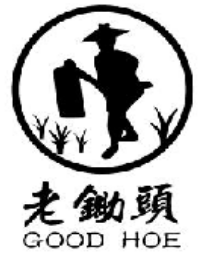In a recently published retrial decision of an administrative lawsuit concerning trade mark invalidation, the Supreme People’s Court of China ("SPC") clarified that the registration of a subsequent trade mark may infringe prior copyrights in a graphic work, even if the copyrighted element occupies a minor portion of the disputed mark.
Basic Facts
In 2016, Mr. Li, a Chinese individual, created an artistic work featuring the text “老锄头 (good hoe)” and an image of a farmer holding a hoe (specimen below). In the same year, he applied for trade mark registration (No. 19354087) for goods in Class 31 (“trees; plants, etc.”) and registered it as a copyrighted artwork. The trade mark was granted in 2017.

(TM No. 19354087 & Copyrighted artwork)
A Chinese company applied for trade mark registration (No. 39873730, specimen below) in 2019, which was registered in 2020 for goods in Class 1 (“fertilizers, etc.”). The farmer image in this mark resembled Li’s work but occupied a relatively minor proportion within the overall mark.

(TM No. 39873730 [without the indicative arrow])
Li filed an invalidation action against the disputed mark on the grounds of copyright infringement and others, which was not supported by the China National Intellectual Property Administration ("CNIPA"). The CNIPA held that the disputed mark lacked substantial similarity to Li’s copyrighted work in the sense of copyright law, and therefore did not constitute infringement.
Li subsequently initiated administrative litigation. The Beijing Intellectual Property Court (first instance) ruled that the disputed mark infringed Li’s copyright by incorporating a farmer image substantially similar to his work, thereby overturning CNIPA’s decision.
The CNIPA appealed. The second-instance court, the Beijing Higher People’s Court, held that the image of the farmer in the disputed mark accounts for a small portion of the mark, and that the main identifying part of the mark is the green Chinese character “耕” (meaning “farming”), with the overall structure and visual effect of the mark differing significantly from that of Mr. Li's copyright work, and therefore, does not constitute copyright infringement. Accordingly, it overturned the first-instance judgment.
Li petitioned for a retrial before the SPC, which ultimately ruled in his favour.
Key Points of the SPC Ruling
The SPC first affirmed that the “farmer holding a hoe” image qualifies as a copyright-protected artistic work. It further held that the corresponding image in the disputed mark was nearly identical to Li’s work in terms of character posture, hoe shape, positioning, design techniques, and visual effects, thereby establishing substantial similarity under copyright law. The court emphasised that the determination of copyright infringement shall not hinge on the proportional size of the copied element. Consequently, the SPC revoked the second-instance judgment and CNIPA’s original decision, ruling that the disputed mark infringed Li’s prior copyright.
Takeaways
The SPC’s ruling sparked public debate due to the minimal proportion of the infringing element in the disputed mark, rendering the outcome seemingly unexpected.
However, this case clarifies that copyright infringement hinges on the copying of a “substantial part” rather than the proportion of the copied element. Even a minor infringing component in a trade mark may constitute infringement if it materially harms prior rights. This reflects judicial protection of “prior rights” including copyright and rectifies the over-reliance on “holistic comparison” in infringement determinations.
The case underscores the importance for creators to promptly secure trade mark registrations, copyright registrations, and preservation of publication evidence in order to safeguard their rights and combat potential infringements effectively.


/Passle/6130aaa9400fb30e400b709a/SearchServiceImages/2025-12-19-13-59-57-090-69455a5d9b03a4fc9265ecc4.jpg)
/Passle/6130aaa9400fb30e400b709a/SearchServiceImages/2025-12-19-11-34-12-495-694538345f578b1a57f1e88e.jpg)
/Passle/6130aaa9400fb30e400b709a/SearchServiceImages/2025-12-17-14-35-35-196-6942bfb76438b978e7e85214.jpg)